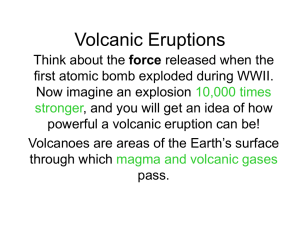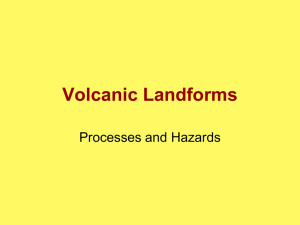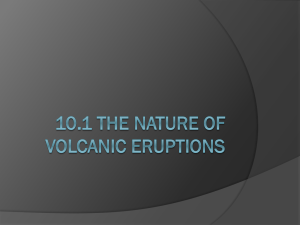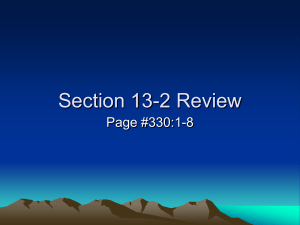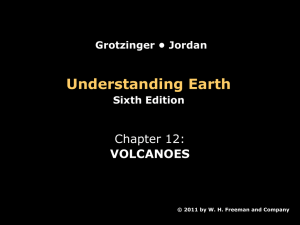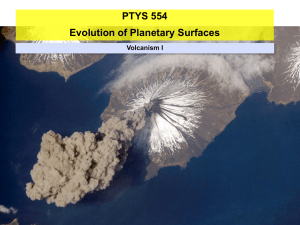Lab 5 Lecture
advertisement
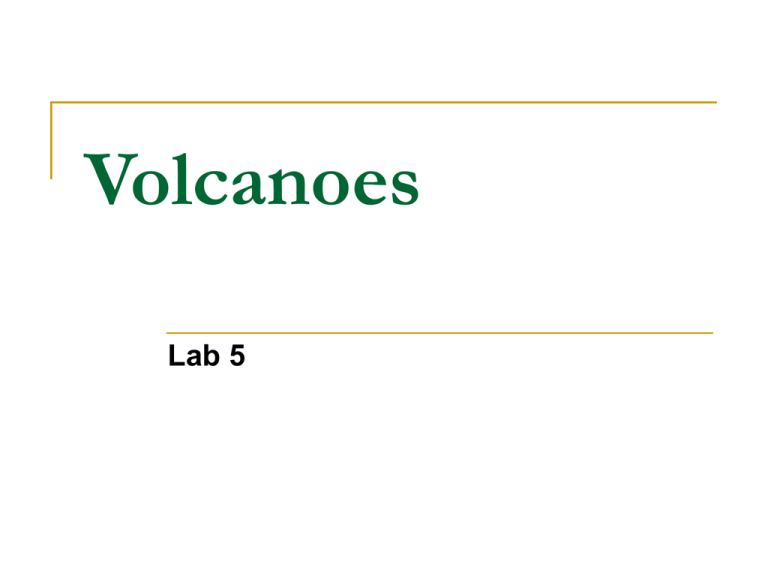
Volcanoes Lab 5 Concepts Location of active volcanoes Volcanism 3 categories Viscosity 5 types of extrusive volcanism Examples of each 3 types of lava flows Dangers of volcanic eruptions What do you notice about their locations? Volcanism Definition: the origin and movement of magma Three categories Extrusive: magma is expelled onto surface Intrusive: magma solidifies in the shallow crust near the surface. Can be exposed after weathering. Plutonic: magma solidifies deep inside the crust. Viscosity: The ability for lava to flow. Reflective of the amount of silica present in the magma. LOW silica = LOW viscosity = nonexplosive HIGH silica = HIGH viscosity = explosive Volcanism Extrusive Examples Mt. Shasta, CA Mt. Fuji, Japan Volcanism Intrusive Examples Right: Stone Mountain, GA Below: Devil’s Tower, WY Volcanism Plutonic Examples 5 Types of Extrusive Volcanism 1. Shield Volcano Central vent allows magma from chamber to spill out, slowly building the volcano in layers. Produces wide, gently sloping mountains Best example: Hawai’ian volcanoes (right: Mauna Loa) 5 Types of Extrusive Volcanism 2. Composite Volcano “Stratovolcano” Central vent allows magma to come up from chamber below Produces symmetrical, steep-sloped mountains Most “explosive” type of volcano Examples: Mt Fuji, Mt Shasta, Mt St Helens 5 Types of Extrusive Volcanism 2. Composite Volcano example: Mt St Helens in 1980 5 Types of Extrusive Volcanism 3. Caldera Volcano Formed when the upper part of a volcano collapses The magma chamber below is (partially or completely) emptied after an eruption The emptied magma chamber can no longer support the weight of the overlying rock The overlying rock collapses into itself, forming a circular basin Volcanic activity can continue if there is still magma in the chamber below Example: Crater Lake, OR 5 Types of Extrusive Volcanism 3. Caldera Volcano example: Crater Lake, OR Crater Lake was formed after Mt Mazama (a stratovolcano) erupted and collapsed back in on itself. 5 Types of Extrusive Volcanism 4. Cinder Cones Smallest mountain formation of all volcanic landform types Cone-shaped peaks build up from small, solid particles, ejected into air by small volcanic vent Generally <1,500’ high Example: Wizard Island 5 Types of Extrusive Volcanism 4. Cinder Cone example: Wizard Island in Crater Lake, OR 5 Types of Extrusive Volcanism 5. Lava Dome “Plug Dome” High-silica lava exits from a vent. Due to its high viscosity (doesn’t flow very fast or far), it builds up into a dome. Effectively “plugs” the main vent. Can still emit ash, gases, and even lava. Example: Lava Dome in Mt St Helen’s crater. 3 Types of Lava Flows ’A’a “Clinky” Blocky, choppy lava flows that does not flow well over land Pahoehoe “Smooth, unbroken lava” Ropy surface Pillow Lava Lava emerges from underwater volcanic vents Lava cools & crusts when it hits colder water When crust fractures, lava oozes out and creates billowing pillows ’A’a Pahoehoe Pillow Lava Dangers of Volcanic Eruptions Burning Hot Lava Earthquakes, Landslides and Tsunamis These are often related – an earthquake might jar some land loose, resulting in a landslide. The earthquake may set off the tsunami. Also, if the landslide falls into the ocean, can trigger a tsunami. Mudslides (“Lahars”) Ash Fallout Pyroclastic Flow (“nuée ardente”) Dangers of Volcanic Eruptions Mudslide (Lahar) examples Mt. Pinatubo, Philippines 1991 eruption Mt. St. Helens, WA 1980 eruption Dangers of Volcanic Eruptions Ash fallout example: Mt. Pinatubo, Philippines 1991 eruption Dangers of Volcanic Eruptions Ash fallout example: Mt. St. Helens 1980 eruption Dangers of Volcanic Eruptions Pyroclastic flow example: Mt St Helens 1980 eruption Hot gases, ash, rock that become a “fluid cloud” that move down the side of the volcano. Can travel great distances. “nuée ardente”: French for “glowing cloud”




